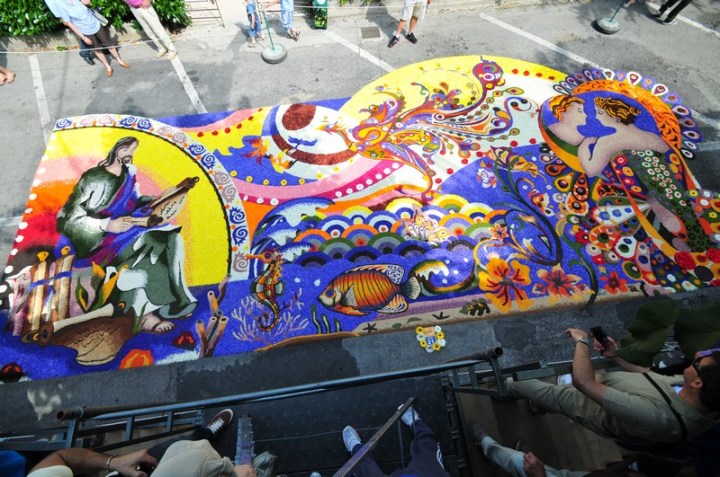Spello is a municipality in Italy’s central region of Umbria with roots in antiquity. Located about 10 kilometers (6 mi) from Assisi, on the opposite side of Mt. Subasio, like Assisi, it was inhabited by ancient Umbri until Roman occupation in the 1st century BC. Like the rest of the region, it was evangelized largely from the 2nd through 4th centuries.
Though overshadowed by the nearby city of Sts. Francis and Clare, Spello is worth a visit for its striking churches and artwork. The church of Santa Maria Maggiore boasts the Baglioni chapel with frescoes by Perugino and Pinturicchio from the high Renaissance. The church of Sant’Andrea (St. Andrew) also has a work by Pinturicchio – a wooden panel depicting the Virgin with Child.
San Lorenzo the Martyr has an “old world” feel to it, as if untouched by time. The interior of this 12th-century church boasts some beautiful pieces of artwork, from the large central wooden canopy from the 17th century to the beautiful fresco of the “Mystic Marriage of Santa Caterina” dating from the year 1435 and two angels fresco from the 16th century. For a simpler church, there is the Capuchin church of San Severino. Located in the upper part of Spello, adjacent a stunning panoramic belvedere, it is smaller and more intimate.
The “Infiorate” on the feast of Corpus Christi (or Corpus Domini)
In addition to its beautiful churches, Spello is known throughout the country for a particular religious tradition that takes place just one day a year. On the feast of Corpus Domini (known as Corpus Christi in the English-speaking world), the winding streets of the historic center are decorated with expansive floral “carpets” and displays. Locals refer to it as the Infiorate. The displays are remarkable in the quality of the depictions and the sheer number and size of the images.

The earliest record of such a floral decoration in Spello was discovered in the historical archives of the church of Santa Maria Maggiore dating to the early 17th century. In another document, from the municipal archive, the citizens were asked to decorate the streets in front of their homes with flowers or vegetables in honor of the city’s new bishop in 1831.

The contemporary Infiorate dates to the early 1900s. By then, a tradition of creating elaborate floral compositions had taken root in Spello. Early on, they were created by families in honor of the feast of Corpus Domini out of devotion to the Holy Eucharist.
By the 1960s, the tradition had evolved into a competition among expert flower growers and artists, their works judged in terms of technique, precision, and creativity. Winners of the competition are awarded with a bronze statue of the poet Sesto Properzio, an ancient Roman poet born in nearby Assisi, which is kept by the winning group until the following competition.

Work on the Infiorate begins months prior to the feast. First, a wide array of flowers are chosen. (Materials must consist of flower petals, leaves, or other natural materials, with the exception of wood, which is prohibited.) Though the flowers are collected mostly from Mount Subasio and the nearby Apennine Mountains, some are collected hundreds of kilometers away. The flowers include: cornflower, rose, carnation, poppy, fennel, vetch, iris, broom, elder, daisy, dandelion, thistle, serputello, plantago, viscaria, sage, linaria, calendula, anemone, cicirilli, magnolia, spring onion, gaggia, fig, oak, walnut, cypress, pine, wild orchid.

As the feast approaches, large teams of infioratori (the creators of the designs) descend along the slopes of Mt. Subasio and the Umbrian valley to begin work in earnest. In what is known as the capatura, the flowers are separated by type and color, followed by a meticulous drying process.
On the evening prior to Corpus Domini, the streets of Spello are closed to traffic. Adequate lighting systems are set up and, depending on the weather, barriers and awnings are erected to protect the works from rain and wind.

First, images are drawn on the pavement with chalk or on paper that is glued to the pavement. Then the petals are laid directly on the paper or pavement with no adhesive compound. According to the competition’s rules, the designs must be at least 12 meters (39 feet) long.
The work lasts throughout the night. By 8:00 a.m., the works must be finished. By then, the streets are covered with long, fragrant “carpets” of beautiful designs. For the next few hours, the works are conserved with a system of water pumps and sprinklers to maintain the petals’ adherence to the floor and prevent them from withering in the sun.

After Mass is celebrated by the bishop of Foligno in the Church of Santa Maria Maggiore, a long procession emerges. While the bishop carries a monstrance displaying the Holy Eucharist, the crowd passes directly over the floral designs on the streets. After that point, anyone can walk on the designs, which have fulfilled their purpose.
Though it may seem a waste to observe such beautiful, meticulously prepared displays trampled on, the tradition has scriptural meaning: “Unless a grain of wheat falls to the ground and dies, it remains just a grain of wheat; but if it dies, it produces much fruit” (John 12: 24).


